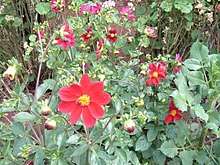Dahlia pinnata
| Dahlia pinnata | |
|---|---|
 | |
| Scientific classification | |
| Kingdom: | Plantae |
| Clade: | Angiosperms |
| Clade: | Eudicots |
| Clade: | Asterids |
| Order: | Asterales |
| Family: | Asteraceae |
| Genus: | Dahlia |
| Species: | D. pinnata |
| Binomial name | |
| Dahlia pinnata | |
| Synonyms | |
| |
Dahlia pinnata (D. × pinnata) is a species in the genus Dahlia, family Asteraceae, with the common name garden dahlia. It is the type species of the genus and is widely cultivated.
Description
Dahlia pinnata is a perennial herbaceous plant with a rhizome and tuberous roots, reaching a height of 70 to 120, rarely 160 centimeters. The stem is erect being branched only in the inflorescence. The leaves are usually simple, with leaflets that are ovate and 5–10 cm long.
The two to eight flower heads have a diameter of 6 to 10 centimeters on 5 to 15 centimeters long stems. The eight florets have a length of 3 to 5 centimeters, are ovate and coloured pink to deep purple.
Taxonomy
Hansen and Hjerting in (1996)[2] demonstrated that Dahlia pinnata should more properly be designated D. x pinnata. D. x pinnata was shown to actually be a variant of D. sorensenii that had acquired hybrid qualities before it was introduced to Europe in the sixteenth century and formally named by Cavanilles.[3] The original wild D. pinnata is presumed extinct.
Distribution and habitat
Ecology
The flowering period extends from July to October.
Cultivation
Used as an ornamental plant, and was cultivated by the Aztecs before the discovery of America, and was introduced to Spain in 1798. Modern dahlias are often the product of hybridisation between D. pinnata and D. coccinea.
References
- ↑ Icon 1: 57 (t. 80).
- ↑ Hansen, H. V. and J. P. Hierting. 1996. Observations on chromosome numbers and biosystematics in Dahlia (Asteraceae, Heliantheae) with an account on the identity of D. pinnata, D.rosea and D. coccinea. Nordic Journal of Botany 16: 445-455.
- ↑ Cavanilles, A. J. 1791. Icones et Descriptiones Plantarum 1: 57.
External links
| Wikispecies has information related to Dahlia pinnata |
| Wikimedia Commons has media related to Dahlia pinnata. |